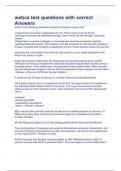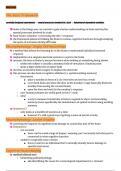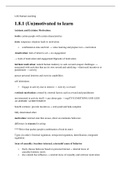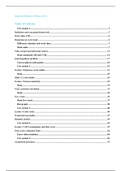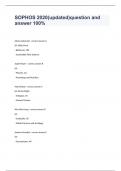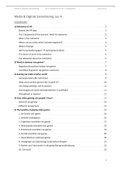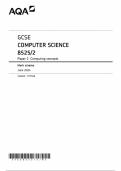Lecture notes Molecular Virology
Introduction
Virus: a genetic entity (DNA or RNA) protected by a protein coat and
sometimes a lipid membrane, which upon infection of a suitable host,
controls the synthesizing system of the cell in such a way that new viruses
are produced. The three main properties are:
1. Infectivity (property to infect a cell, to multiply, and leave the cell)
2. Property to stably survive in an extracellular state
3. Obligatory, intracellular parasites (need to hijack a host cell)
Viroids and prions are even smaller pathogens than viruses. Viroids (only
RNA) cannot code for anything, but it can still cause serious diseases (especially in plant
development). Prions are misfolded proteins and by interaction with a functional protein, it can turn
this into a similar dysfunctional protein. Creutzfeldt-Jacob is the most known disease associated with
prions.
Virus composition: there is always some sort of viral genome (RNA, DNA, single-stranded, double-
stranded, negative polarity, positive polarity etc), surrounded by a coat protein. A lipid membrane
and an envelope of glycoproteins can surround the coat protein.
Baltimore made a classification system
for viruses based on what type of virus
they are (DNA, RNA or reverse
transcribing) and if they are double
stranded or single stranded. Single
stranded negative RNAs can immediately
be converted to mRNA, positive single
stranded RNA first has to be converted to
a negative form. Single stranded DNA
first has to be converted to a double
stranded form.
Minus stranded RNAs always contain a
polymerase in the molecule to convert it
to a plus stranded RNA molecule. This is
because plus stranded RNA molecules
are immediately translational, negative strands are not immediately translational and are thus not
infectious. In the image: the produced mRNA is positive (= needed for translation).
, The protein shell is built up by smaller subunits, the coat
proteins. This is done to increase genetic stability (smaller
protein = smaller gene = less mutations), for saving genetic
space, and for easy disassembly. Also, these particles are used
to create a symmetric virus particle. Viruses need to be
symmetrical to escape from immunity (weird forms are often
recognized). The first discovered virus shapes were the rod-
shaped viruses. Rod-shaped viruses use helical (not circular)
symmetry.
Icosahedral shape: one form of a platonic body with the most
symmetry. All isometric viruses have an icosahedral symmetry
but can be smaller or larger in diameter depending on the
genome size. The triangulation number indicates the size of
the particle: the higher the T, the bigger the particle.
Infection is a multistep process:
Attachment
(Internalization in endosomes)
Fusion
Transport
Once a virus is replicated, it produces a capsid structure, after which it moves to the cell membrane.
Now, the virus can leave from the cell membrane. The entire cell
can also bursts to release the virus material.
Classification of viruses is based on molecular architecture,
replication strategy, genetic relatedness, and host organism.
Plant viruses: positive sense RNA viruses
Plant viruses are also classified using the Baltimore classification.
The major part of plant viruses (77%) is single stranded positive.
Positive RNA works as messenger RNA: as soon as they are in a
cell, they can be translated (there is no further transcription
needed as for negative sense RNA).
Cellular mRNAs have a cap at the 5’-terminus to protect the RNA but also to give signals where the
machinery should bind for translation. The 3’-terminus is protected by a poly(A) tail. The plant
machinery only translates monocistronic (only to produce 1 protein) messenger RNA with one open
reading frame. However, the plant virus has multiple open reading frames, so that the virus can
produce multiple proteins with the same piece of RNA. Viruses use the translation machinery from
the host cell. There are different methods that the virus can use to translate the RNA (since the plant
machinery only translates monocistronic RNA):
Segmentation of the genome: cutting of the polycistronic RNA
Subgenomic RNAs (temporal regulation of gene expression): RNA polymerase recognizes
internal binding sites to produce shorter RNA fragments. The shorter RNA piece is called
subgenomic RNA and can also encode for different proteins. An example is the cucumber
mosaic virus. There are three types of genomic RNAs, and using internal initiation, two more
subgenomic RNAs can be produced.
, Read-through translation (leaky termination or initiation): a weak start codon at the
beginning and a weak stop codon at the end make sure that the RNA polymerase can
continue with translation (they don’t recognize the codons).
Frame shifting: sometimes, open reading frames overlap. The ribosome can then bind to the
first start codon and can shift to the other ORF to produce the other protein (=ribosomal
shift).
Polyprotein processing (requires a viral protease) : after translation, the polyprotein can be
cut into single proteins.
Tobacco mosaic virus: only has 1 genomic RNA, but can also produce multiple proteins. They do this
by using read-through (amber UAG is
the leaky stop codon) or subgenomic
RNAs strategies. They produce two
different protein versions that can form
a dimer to function as a RNA
polymerase.
Potato virus Y: use polyprotein
processing as a translation strategy. The
RNA only has one start codon and one stop codon, so translation happens normally. After translation,
the polyprotein is cut using proteolytic cleavage to produce different proteins. The functions of the
plant virus proteins are very diverse. They can form coat proteins, RNA polymerases, proteases,
movement proteins etc.
Infection cycle of a positive sense RNA virus:
1. Virus entrance to the host cell: viruses enter the plant cell through a mechanical rupture in
the cuticle and cell wall caused by piercing (nematodes, thrips, whiteflies) or biting (beetle),
but can also be caused by mechanical damage.
2. Co-translational disassembly: as soon as the virus is in the cell, the coat protein starts to fall
off. The positive strand is made negative to produce more positive strands (only negative
strands can make positive strands).
3. Genome replication and massive translation: replication
takes place in the cytoplasm.
4. Assembly of new virions and accumulation in the
cytoplasm
5. Local movement of virions and RNA
6. Systemic spread to other parts of the plant
7. Transmission to other hosts
Brome mosaic virus: produces a protein (2a) that binds to the 5’-
end of the mRNA to force the formation of the replication
complex (see image). They form a vesicle for RNA replication and
function in defence against plant antiviral compounds.
All plus sense viruses modify cytoplasmic membranes to form
functional sites of RNA synthesis and protein translation and
processing. These sites, containing cellular membranes, viral RNA,
and viral replicase proteins, are generally referred to as replication
complexes (RCs).
Plant antiviral defence uses RNA interference:
Introduction
Virus: a genetic entity (DNA or RNA) protected by a protein coat and
sometimes a lipid membrane, which upon infection of a suitable host,
controls the synthesizing system of the cell in such a way that new viruses
are produced. The three main properties are:
1. Infectivity (property to infect a cell, to multiply, and leave the cell)
2. Property to stably survive in an extracellular state
3. Obligatory, intracellular parasites (need to hijack a host cell)
Viroids and prions are even smaller pathogens than viruses. Viroids (only
RNA) cannot code for anything, but it can still cause serious diseases (especially in plant
development). Prions are misfolded proteins and by interaction with a functional protein, it can turn
this into a similar dysfunctional protein. Creutzfeldt-Jacob is the most known disease associated with
prions.
Virus composition: there is always some sort of viral genome (RNA, DNA, single-stranded, double-
stranded, negative polarity, positive polarity etc), surrounded by a coat protein. A lipid membrane
and an envelope of glycoproteins can surround the coat protein.
Baltimore made a classification system
for viruses based on what type of virus
they are (DNA, RNA or reverse
transcribing) and if they are double
stranded or single stranded. Single
stranded negative RNAs can immediately
be converted to mRNA, positive single
stranded RNA first has to be converted to
a negative form. Single stranded DNA
first has to be converted to a double
stranded form.
Minus stranded RNAs always contain a
polymerase in the molecule to convert it
to a plus stranded RNA molecule. This is
because plus stranded RNA molecules
are immediately translational, negative strands are not immediately translational and are thus not
infectious. In the image: the produced mRNA is positive (= needed for translation).
, The protein shell is built up by smaller subunits, the coat
proteins. This is done to increase genetic stability (smaller
protein = smaller gene = less mutations), for saving genetic
space, and for easy disassembly. Also, these particles are used
to create a symmetric virus particle. Viruses need to be
symmetrical to escape from immunity (weird forms are often
recognized). The first discovered virus shapes were the rod-
shaped viruses. Rod-shaped viruses use helical (not circular)
symmetry.
Icosahedral shape: one form of a platonic body with the most
symmetry. All isometric viruses have an icosahedral symmetry
but can be smaller or larger in diameter depending on the
genome size. The triangulation number indicates the size of
the particle: the higher the T, the bigger the particle.
Infection is a multistep process:
Attachment
(Internalization in endosomes)
Fusion
Transport
Once a virus is replicated, it produces a capsid structure, after which it moves to the cell membrane.
Now, the virus can leave from the cell membrane. The entire cell
can also bursts to release the virus material.
Classification of viruses is based on molecular architecture,
replication strategy, genetic relatedness, and host organism.
Plant viruses: positive sense RNA viruses
Plant viruses are also classified using the Baltimore classification.
The major part of plant viruses (77%) is single stranded positive.
Positive RNA works as messenger RNA: as soon as they are in a
cell, they can be translated (there is no further transcription
needed as for negative sense RNA).
Cellular mRNAs have a cap at the 5’-terminus to protect the RNA but also to give signals where the
machinery should bind for translation. The 3’-terminus is protected by a poly(A) tail. The plant
machinery only translates monocistronic (only to produce 1 protein) messenger RNA with one open
reading frame. However, the plant virus has multiple open reading frames, so that the virus can
produce multiple proteins with the same piece of RNA. Viruses use the translation machinery from
the host cell. There are different methods that the virus can use to translate the RNA (since the plant
machinery only translates monocistronic RNA):
Segmentation of the genome: cutting of the polycistronic RNA
Subgenomic RNAs (temporal regulation of gene expression): RNA polymerase recognizes
internal binding sites to produce shorter RNA fragments. The shorter RNA piece is called
subgenomic RNA and can also encode for different proteins. An example is the cucumber
mosaic virus. There are three types of genomic RNAs, and using internal initiation, two more
subgenomic RNAs can be produced.
, Read-through translation (leaky termination or initiation): a weak start codon at the
beginning and a weak stop codon at the end make sure that the RNA polymerase can
continue with translation (they don’t recognize the codons).
Frame shifting: sometimes, open reading frames overlap. The ribosome can then bind to the
first start codon and can shift to the other ORF to produce the other protein (=ribosomal
shift).
Polyprotein processing (requires a viral protease) : after translation, the polyprotein can be
cut into single proteins.
Tobacco mosaic virus: only has 1 genomic RNA, but can also produce multiple proteins. They do this
by using read-through (amber UAG is
the leaky stop codon) or subgenomic
RNAs strategies. They produce two
different protein versions that can form
a dimer to function as a RNA
polymerase.
Potato virus Y: use polyprotein
processing as a translation strategy. The
RNA only has one start codon and one stop codon, so translation happens normally. After translation,
the polyprotein is cut using proteolytic cleavage to produce different proteins. The functions of the
plant virus proteins are very diverse. They can form coat proteins, RNA polymerases, proteases,
movement proteins etc.
Infection cycle of a positive sense RNA virus:
1. Virus entrance to the host cell: viruses enter the plant cell through a mechanical rupture in
the cuticle and cell wall caused by piercing (nematodes, thrips, whiteflies) or biting (beetle),
but can also be caused by mechanical damage.
2. Co-translational disassembly: as soon as the virus is in the cell, the coat protein starts to fall
off. The positive strand is made negative to produce more positive strands (only negative
strands can make positive strands).
3. Genome replication and massive translation: replication
takes place in the cytoplasm.
4. Assembly of new virions and accumulation in the
cytoplasm
5. Local movement of virions and RNA
6. Systemic spread to other parts of the plant
7. Transmission to other hosts
Brome mosaic virus: produces a protein (2a) that binds to the 5’-
end of the mRNA to force the formation of the replication
complex (see image). They form a vesicle for RNA replication and
function in defence against plant antiviral compounds.
All plus sense viruses modify cytoplasmic membranes to form
functional sites of RNA synthesis and protein translation and
processing. These sites, containing cellular membranes, viral RNA,
and viral replicase proteins, are generally referred to as replication
complexes (RCs).
Plant antiviral defence uses RNA interference:


